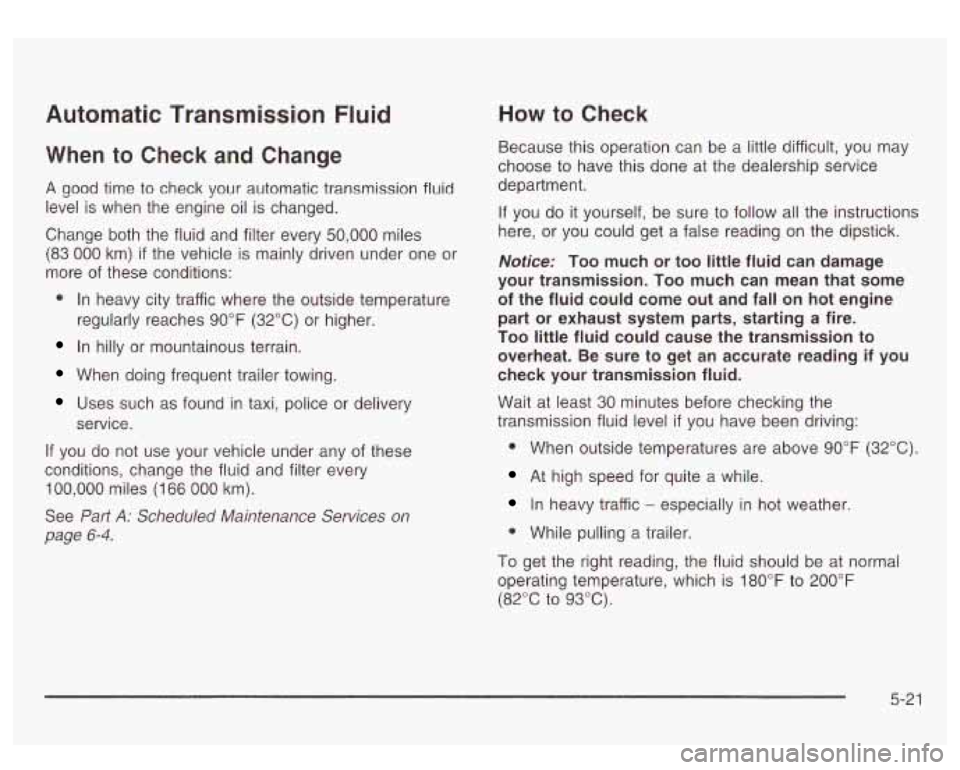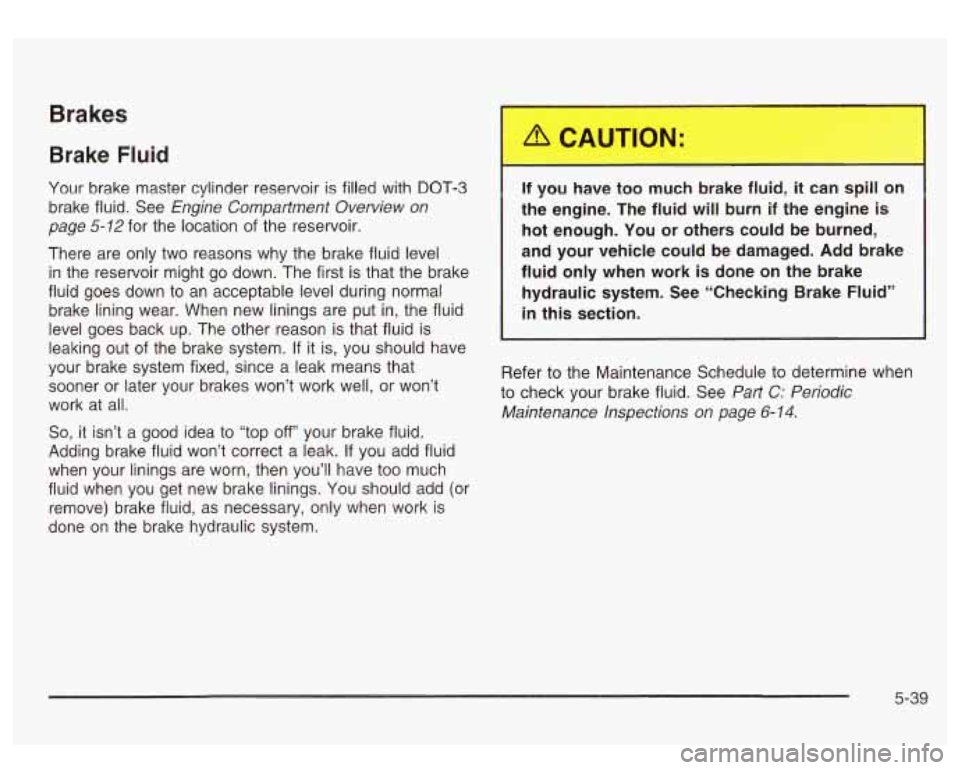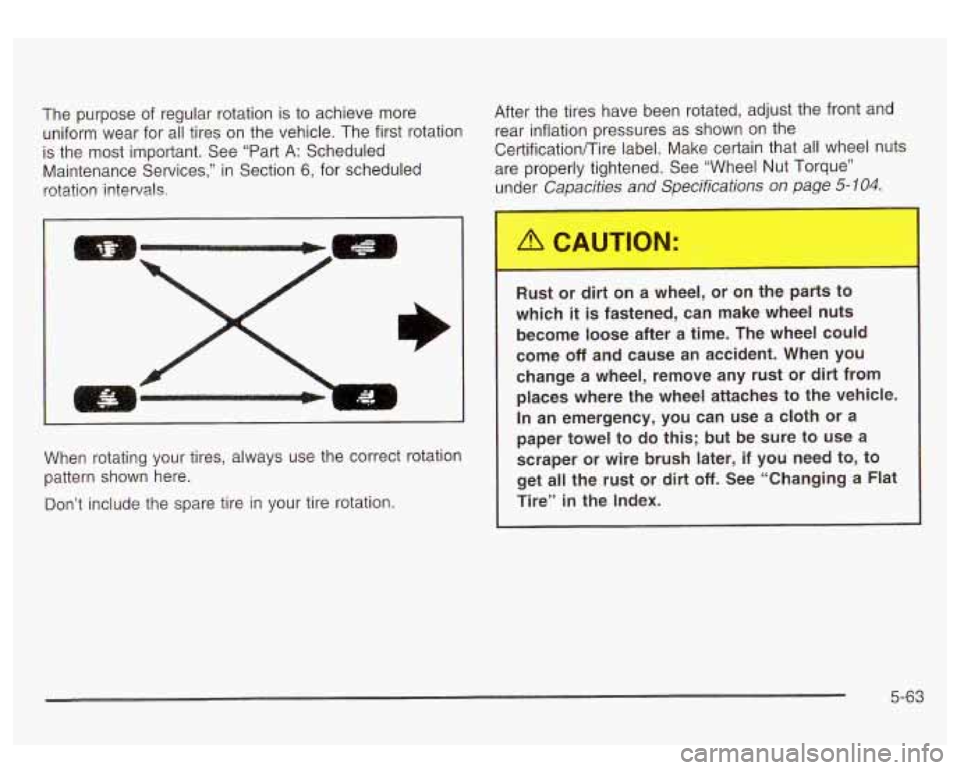Page 290 of 428

Automatic Transmission Fluid
When to Check and Change
A good time to check your automatic transmission fluid
level
is when the engine oil is changed.
Change both the fluid and filter every
50,000 miles
(83
000 km) if the vehicle is mainly driven under one or
more
of these conditions:
In heavy city traffic where the outside temperature
regularly reaches 90°F (32°C) or higher.
In hilly or mountainous terrain.
When doing frequent trailer towing.
Uses such as found in taxi, police or delivery
If you do not use your vehicle under any of these
conditions, change the fluid and filter every
100,000 miles (1 66 000 km).
See
Part A: Scheduled Maintenance Services on
page
6-4.
service.
How to Check
Because this operation can be a little difficult, you may
choose to have this done at the dealership service
department.
If you do it yourself, be sure to follow all the instructions
here, or you could get a false reading on the dipstick.
Notice: Too much or too little fluid can damage
your transmission. Too much can mean that some
of the fluid could come out and fall on hot engine
part
or exhaust system parts, starting a fire.
Too little fluid could cause the transmission to overheat. Be sure to get an accurate reading if you
check your transmission fluid.
Wait at least
30 minutes before checking the
transmission fluid level
if you have been driving:
0 When outside temperatures are above 90°F (32°C).
At high speed for quite a while.
In heavy traffic - especially in hot weather.
While pulling a trailer.
To get the right reading, the fluid should be at normal
operating temperature, which is 180°F
to 200°F
(82°C to 93°C).
5-2
1
Page 292 of 428

~~ 3. Check
both sides of the dipstick, and read the lower
level. The fluid level must be in the
COLD area,
below the cross-hatched area, for a cold check or in
the HOT area or cross-hatched area for a hot check.
4. If the fluid level is in the acceptable range, push the
dipstick back in all the way; then flip the handle
down to lock the dipstick in place.
How to Add Fluid
Refer to the Maintenance Schedule to determine what
kind of transmission fluid
to use. See Part D:
Recommended Fluids and Lubricants on page
6-16.
Add fluid only after checking the transmission fluid while
it is hot.
(A cold check is used only as a reference.)
If the fluid level is
low, add only enough of the proper
fluid to bring the level up to the
HOT area for a hot
check. It doesn’t take much fluid, generally less than one
pint
(0.5 L). Don’t overfi//.
Notice: We recommend you use only fluid labeled
DEXRON@
111, because fluid with that label is
made especially for your automatic transmission.
Damage caused by fluid other than DEXRON@
111 is
not covered by your new vehicle warranty.
@ After adding fluid, recheck the fluid level as
described under “How to Check”.
When the correct fluid level is obtained, push the
dipstick back in all the way; then flip the handle
down
to lock the dipstick in place.
5-23
Page 308 of 428

Brake Fluid
Your brake master cylinder reservoir is filled with DOT-3
brake fluid. See
Engine Compantment Overview on
page
5-12 for the location of the reservoir.
There are only two reasons why the brake fluid level
in the reservoir might go down. The first is that the brake
fluid goes down to an acceptable level during normal
brake lining wear. When new linings are put in, the fluid
level goes back
up. The other reason is that fluid is
leaking out of the brake system.
If it is, you should have
your brake system fixed, since a leak means that
sooner or later your brakes won’t work well, or won’t
work at all.
So, it isn’t a good idea to “top off your brake fluid.
Adding brake fluid won’t correct a leak.
If you add fluid
when your linings are worn, then you’ll have too much
fluid when you get new brake linings. You should add (or
remove) brake fluid, as necessary, only when work is
done
on the brake hydraulic system.
If yo, ..rave 1,- _._____ rake ---id, it ~~-1 spill on
the engine. The fluid will burn if the engine is
hot enough. You or others could be burned,
and your vehicle could be damaged. Add brake
fluid only when work is done on the brake
hydraulic system. See “Checking Brake Fluid”
in this section.
Refer to the Maintenance Schedule to determine when
to check your brake fluid. See
Part C: Periodic
Maintenance Inspections on page 6-14.
5-39
Page 318 of 428
All-Wheel Drive
Lubricant checks in this section also apply to these
vehicles. However, there are two additional systems that
need lubrication.
Transfer Case
When to Check Lubricant
Refer to the Maintenance Schedule to determine how
often to check the lubricant. See
Part C: Periodic
Maintenance Inspections on page
6- 14.
How to Check Lubricant
To get an accurate reading, the vehicle should be on a
level surface.
If the level
is below the bottom of the filler plug hole,
you’ll need to add some lubricant. Add enough lubricant
to raise the level to the bottom of the filler plug hoie.
Use care not to overtighten the plug.
What to Use
Refer to the Maintenance Schedule to determine what
kind of lubricant to use. See
Part D: Recommended
Fluids and Lubricants on page
6-16.
Automatic Transfer Case (A) Fill Plug (B) Drain Plug
5-49
Page 319 of 428
Rear Axle
When to Check Lubricant
Refer to the Maintenance Schedule to determine how
often to check the lubricant. See
PaHA: Scheduled
Maintenance Services on page
6-4.
How to Check Lubricant
To get an accurate reading, the vehicle should be on a
level surface. The
proper level is from
5/8 inch to 1 5/8 inch (1 5 mm to
40 mm) below the bottom of the filler plug hole. Add
only enough fluid to reach the proper level. The proper
level for vehicles with QUADRASTEERTM
(4 Wheel
Steer) is from
0 to 1/4 inch (0 to 6 mm) below the filler
plug hole. Add only enough fluid to reach the proper
level.
What to Use
Refer to the Maintenance Schedule to determine what
kind
of lubricant to use. See Part D: Recommended
Fluids and Lubricants on page
6- 16.
5-50
Page 320 of 428
Front Axle
When to Check Lubricant
Refer to the Maintenance Schedule to determine how
often to check the lubricant. See
Pat? A: Scheduled
Maintenance Services on page
6-4.
How to Check Lubricant
To get an accurate reading, the vehicle should be on a
level surface.
If the level is below the bottom
of the filler plug hole,
you may need to add some lubricant.
When the differential is cold, add enough lubricant to
raise the level to
0 to 3/8 inch (9.5 mm) below the filler
plug hole.
When the differential is at operating temperature
(warm), add enough lubricant to raise the level to the
bottom
of the filler plug hole.
What to Use
Refer to the Maintenance Schedule to determine what
kind of lubricant to use. See
Pat? D: Recommended
Fluids and Lubricants on page
6-16.
5-51
Page 332 of 428

The purpose of regular rotation is to achieve more
uniform wear for all tires on the vehicle. The first rotation
is the most important. See “Part A: Scheduled
Maintenance Services,” in Section
6, for scheduled
rotation
intervals;
After the tires have been rotated, adjust the front and
rear inflation pressures as shown on the
CertificationEire label. Make certain that all wheel nuts
are properly tightened. See “Wheel Nut Torque”
under
Capacities and Specificatiol on ge 5-104.
When rotating your tires, always use the correct rotation
pattern shown here.
Don’t include the spare tire in your tire rotation. Rust or dirt on a
wheel, or on the parts to
which
it is fastened, can make wheel nuts
become loose after a time. The wheel could
come
off and cause an accident. When you
change a wheel, remove any rust or dirt from
places where the wheel attaches to the vehicle,
In an emergency, you can use a cloth or a
paper towel to do
this; but be sure to use a
scraper or wire brush later,
if you need to, to
get all the rust or dirt
off. See “Changing a Flal
Tire”
in the Index.
5-63
Page 376 of 428

Section 6 Maintenance Schedule
Maintenance Schedule ...................................... 6.2
introduction
................................................... 6.2
Your Vehicle and the Environment
.................... 6-2
Maintenance Requirements
.............................. 6-2
How This Section is Organized
......................... 6-3
Part A: Scheduled Maintenance Services
........... 6-4
Using Your Maintenance Schedule
.................... 6-4
Scheduled Maintenance
................................... 6-5
Part
B: Owner Checks and Services ................ 6-10
At Each Fuel Fill
.......................................... 6-10
At Least Once a Month
................ ......... 6-10
At Least Twice a Year
............................... 6-11 At Least
Once a Year
................................... 6-11
Part
C: Periodic Maintenance Inspections ......... 6.14
Steering and Suspension Inspection
................ 6.14
Exhaust System inspection
............................ 6-14
Fuel System Inspection
.................................. 6.14
Engine Cooling System inspection
................... 6.14
(All-Wheel Drive) Inspection
........................ 6.15
Brake System Inspection
................................ 6.15
Part
D: Recommended Fluids and Lubricants .... 6-16
Part E: Maintenance Record
........................... 6.18
Transfer Case and
Front Axle
6- 1